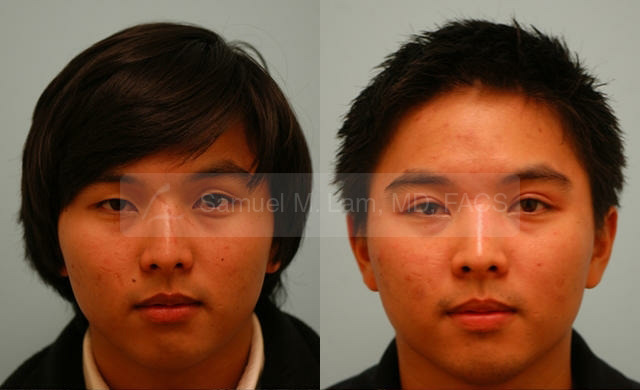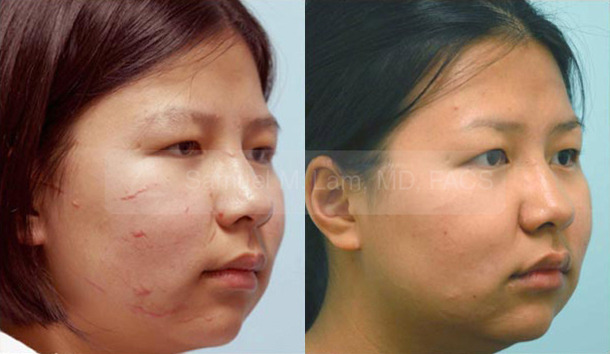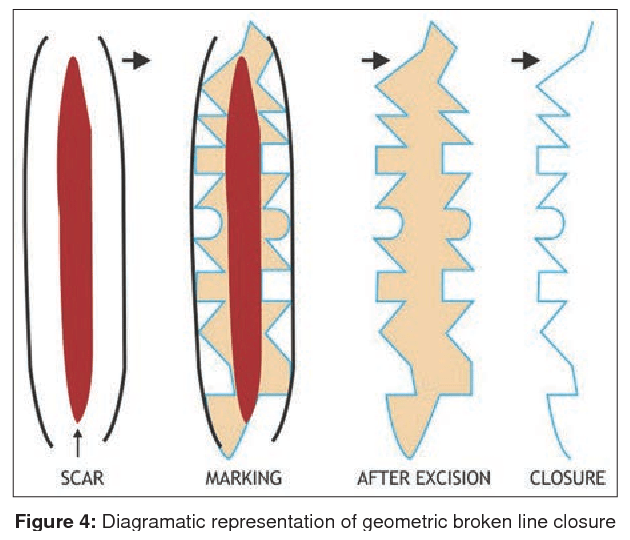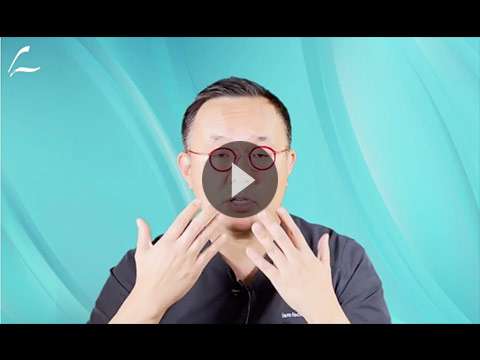Scar Revision Dallas
Jump To:
 Scars on the nose are truly a unique problem that differs from scars on the face for many reasons. First, scars in the lower two-thirds of the nose, especially the lower-third of the nose are hard to close if they are wide because the nasal tip skin is very tight and adherent to the underlying cartilages. Interestingly, the cartilages in the lower third of the nose are very mobile making you think that the skin is loose too but the skin is actually quite tight. The skin becomes progressively more mobile going upward to the top of the nose, as the nasal structures underneath become progressively firmer and harder. If you run your finger up and down on the nasal skin, you will see that you can easily slide it up high on the nose and somewhat ok in the middle and almost not at all along the bottom third of the nose. With this issue in mind, scars must be addressed in a way not to allow tension to occur in the nose when the skin is closed or the scar will widen. In addition, in the nasal tip, removing too much tissue can cause distortion to the nasal tip and particularly the nasal ala, i.e., the nostrils.
Scars on the nose are truly a unique problem that differs from scars on the face for many reasons. First, scars in the lower two-thirds of the nose, especially the lower-third of the nose are hard to close if they are wide because the nasal tip skin is very tight and adherent to the underlying cartilages. Interestingly, the cartilages in the lower third of the nose are very mobile making you think that the skin is loose too but the skin is actually quite tight. The skin becomes progressively more mobile going upward to the top of the nose, as the nasal structures underneath become progressively firmer and harder. If you run your finger up and down on the nasal skin, you will see that you can easily slide it up high on the nose and somewhat ok in the middle and almost not at all along the bottom third of the nose. With this issue in mind, scars must be addressed in a way not to allow tension to occur in the nose when the skin is closed or the scar will widen. In addition, in the nasal tip, removing too much tissue can cause distortion to the nasal tip and particularly the nasal ala, i.e., the nostrils.
Scar Revision Procedure
 To manage this situation of very tight nasal skin, a special kind of undermining of tissues must be performed to achieve a tension-free closure without distortion to the surrounding skin and cartilage. The incision through the skin must be carried down through the muscle layer with undermining or release performed at the so-called sub-SMAS layer, i.e., below the muscle layer and above the periosteum (lining of the bone). The mistake is to make that incision simply under the skin where the tissues may buckle, the blood supply be compromised, and the skin stretch back to widen the scar.
With too much tension, a rotation flap of tissue borrowing from areas of freer tissue may be needed to release the tension or to prevent distortion of tissues. See the section on reconstructive rhinoplasty for some of the principles involved in reconstructive nose surgery. These techniques are critical, especially in the nasal tip for the reasoned mentioned in the previous paragraph.
The principle of scar revision requires achieving an incision that is hard to detect. If the initial scar is wide, white, discolored, raised, or depressed, it may be worth considering a scar revision surgery. To make a linear scar appear less obvious, the preferred method is known as a geometric broken line repair in which the scar is irregularized into tiny trapezoids, triangles, and squares so that a viewer of the scar cannot visualize a straight line making it hard to actually see the scar from a social distance.
To manage this situation of very tight nasal skin, a special kind of undermining of tissues must be performed to achieve a tension-free closure without distortion to the surrounding skin and cartilage. The incision through the skin must be carried down through the muscle layer with undermining or release performed at the so-called sub-SMAS layer, i.e., below the muscle layer and above the periosteum (lining of the bone). The mistake is to make that incision simply under the skin where the tissues may buckle, the blood supply be compromised, and the skin stretch back to widen the scar.
With too much tension, a rotation flap of tissue borrowing from areas of freer tissue may be needed to release the tension or to prevent distortion of tissues. See the section on reconstructive rhinoplasty for some of the principles involved in reconstructive nose surgery. These techniques are critical, especially in the nasal tip for the reasoned mentioned in the previous paragraph.
The principle of scar revision requires achieving an incision that is hard to detect. If the initial scar is wide, white, discolored, raised, or depressed, it may be worth considering a scar revision surgery. To make a linear scar appear less obvious, the preferred method is known as a geometric broken line repair in which the scar is irregularized into tiny trapezoids, triangles, and squares so that a viewer of the scar cannot visualize a straight line making it hard to actually see the scar from a social distance.

Your Scar Revision will be performed by Dr. Lam' surgery center located in Plano, TX.

Dr. Lam did my nose on June 2nd. My mom went to him before me. I wanted the rhinoplasty to make myself look better. Dr. Lam is really nice and thorough, plus he has a really nice office. The recovery was easy, no crazy bruises, and after a week, no one could tell I had surgery. I have already recommended Dr. Lam to someone else.
For Rhinoplasty FAQs, please click here
Learn more about Rhinoplasty with our Rhinoplasty Virtual Consultation
Videos:
For more Rhinoplasty videos, click here
For Rhinoplasty testimonial videos, click here
For Rhinoplasty recovery video diaries, click here
For before-and-after Rhinoplasty photos, click here
For before-and-after Reconstructive Rhinoplasty photos, click here
For before-and-after Revision/Corrective Rhinoplasty photos, click here

 Scar Revision/ Mole Removal on the Nose Virtual Consult
Scar Revision/ Mole Removal on the Nose Virtual Consult